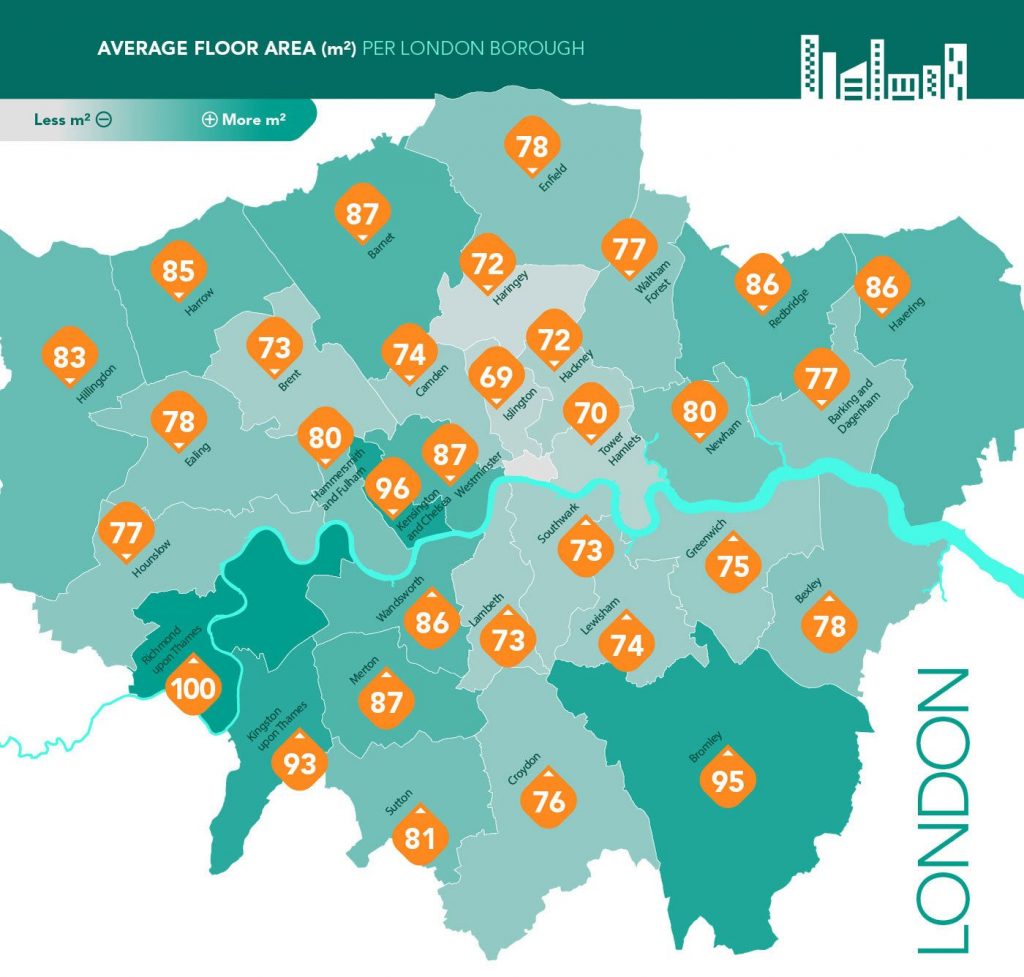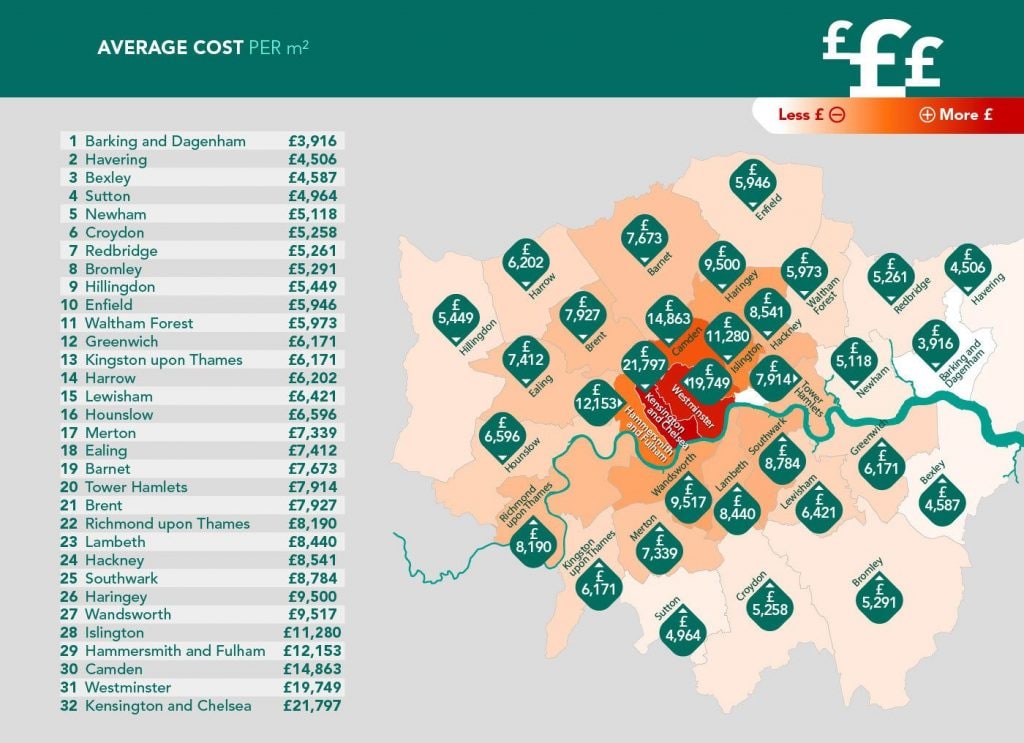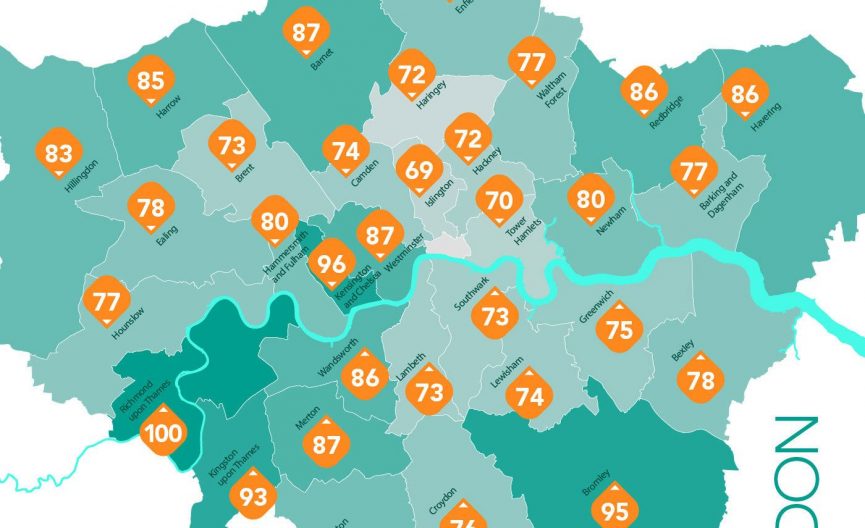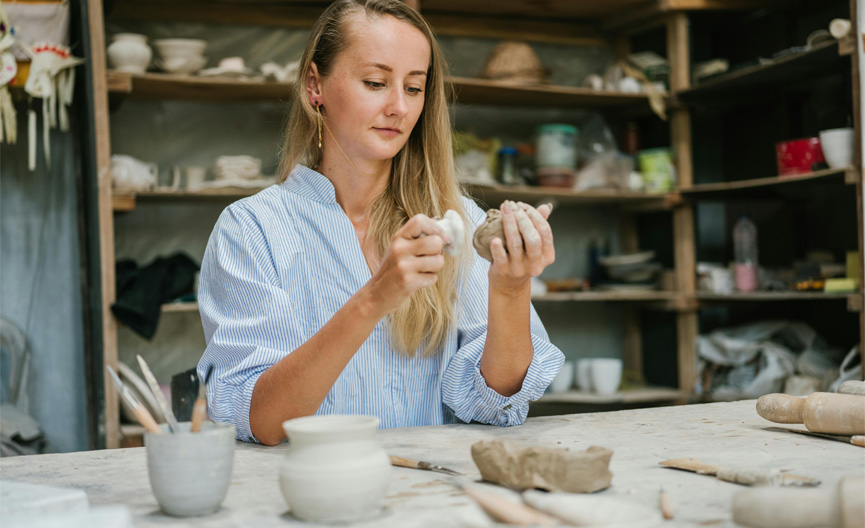London House Price Map: Where Can You Get the Most Space?
When you move to London, you’ll be spending more on your home than you’d be expected to pay anywhere else in the UK. You’ll be getting a lot less floor space for that price, too! While that’s to be expected in the capital, you don’t have to settle for a cramped house to match your cramped surroundings – and you don’t have to move to the most expensive places in London to avoid it. There are some beautiful and sizable houses in the city listed far closer to your budget than you’d expect: you just need to know how to find them.
Which London Boroughs have Bigger Houses?
When you buy a home in London, you’ll be browsing according to the borough. It’d be difficult to narrow down your search if you were looking for homes in Greater London – you might as well type in ‘property in Wales’!
In order to help you figure out which London locale is going to give you the most breathing room, we’ve trawled through government datasets to find the average floor area available in each borough. Don’t worry – we’ll cover their average prices a little further down.

- The closer you live to the countryside, the more space your home is likely to have. You can also expect some pretty big houses next to the southwestern bends of the River Thames.
- The biggest homes are available in Richmond upon Thames, a stately riverside district famous for Kew Gardens. The borough boasts an impressive average house size of 100 square metres!
- Islington has the smallest homes, with an average house size of 69 square metres – perhaps not surprising, since the borough borders the city centre.
- Western boroughs are more likely to have larger homes, while boroughs to the east of the city centre tend to provide less floor space per property.
- Homes north of the Thames are smaller on average, with some of the lowest sizes in Islington, Tower Hamlets, Hackney, Harley and Brent.
What’s the Average Flat Size in Each London Borough?
It’s a big generalisation to take the average house size across every budget imaginable and tell you that you can buy the biggest homes in luxe, riverside Richmond. Everyone in London knows that you can buy the biggest houses in Richmond – that doesn’t mean that it’s on the cards! In reality, you’ll be searching for one of four house types in London: houses, flats, maisonettes and bungalows. Luckily, we’ve got a handy graphic for that, too!

- You’ll find the biggest flats in Westminster, where you can expect to find an average floor space of 76 square metres. That’s not surprising, considering its ties to politics!
- Camden has the largest bungalows, with an average floor area of 120 metres squared – a whopping 23 square metres bigger than the runner up, Croydon.
- Kensington and Chelsea have the largest maisonettes and houses, with an average size of 133 square metres for a maisonette and 213 square metres for a full-size home.
- The smallest homes in London are bungalows in Hammersmith and Fulham, with a record low average of just 26 square metres per home. That’s 18 square metres smaller than the smallest average flat!
- Houses in Westminster are on average twice as big as the houses in Greenwich. The average house floor area of Westminster is 199 square metres and Greenwich is “only” 100 square meters. Which is likely why the cost for square metre is three times cheaper in Greenwich when compared to Westminster.
The Most Expensive Places to Live in London
Now that you know where you can buy the biggest London homes, it’s time to price up the budget. It’s highly unlikely that the average person will be able to afford a stately home in Kensington – so what can you realistically expect to pay for your living space?

What are the Most Expensive London Boroughs per Square Metre?
- The most expensive area to live in London is Kensington and Chelsea – the borough with the biggest houses and maisonettes in the city.
- The average price per square metre in London’s Westminster is a whopping £19,749. The most startling part is that the vast majority of properties that make up that average are flats!
- In Camden, where you can expect to find the 8th smallest homes in London, you’ll be paying £14,863 per square metre.
- The average cost per square metre in Hammersmith and Fulham is twice the cost of Greenwich and four times more expensive than Barking and Dagenham.
Where Can You Find the Lowest Average House Prices in London?
- Barking and Dagenham is the cheapest borough in London, with an average price of £3,916 per square metre. If you are moving there do not forget to check our moving to Barking guide and our self storage units in Barking and Dagenham.
- Barking and Dagenham, Havering, Bexley and Sutton are the only boroughs where floor space is cheaper than £5,000 per square metre.
- Space is cheaper in the suburbs, with average prices going up the closer you are to the city centre.
The Best Place to Buy a Home in London
Considering all of the information, where can you expect to get the most bang for your buck in London? You can buy the biggest houses in Richmond upon Thames and the cheapest houses in Barking and Dagenham, but where falls the happy medium? We’ve drawn up our conclusion, and it looks like this:
| Borough | Average Floor Area (M2) | Average Price per M2 |
| Barking and Dagenham | 77 | £3,916 |
| Havering | 86 | £4,506 |
| Bexley | 78 | £4,587 |
| Sutton | 81 | £4,964 |
| Newham | 80 | £5,118 |
| Croydon | 76 | £5,258 |
| Redbridge | 86 | £5,261 |
| Bromley | 95 | £5,291 |
| Hillingdon | 83 | £5,449 |
| Enfield | 78 | £5,946 |
| Waltham Forest | 77 | £5,973 |
| Kingston upon Thames | 93 | £6,171 |
| Greenwich | 75 | £6,171 |
| Harrow | 85 | £6,202 |
| Lewisham | 74 | £6,421 |
| Hounslow | 77 | £6,596 |
| Merton | 87 | £7,339 |
| Ealing | 78 | £7,412 |
| Barnet | 87 | £7,673 |
| Tower Hamlets | 70 | £7,914 |
| Brent | 73 | £7,927 |
| Richmond upon Thames | 100 | £8,190 |
| Lambeth | 73 | £8,440 |
| Hackney | 72 | £8,541 |
| Southwark | 73 | £8,784 |
| Haringey | 72 | £9,500 |
| Wandsworth | 86 | £9,517 |
| Islington | 69 | £11,280 |
| Hammersmith and Fulham | 80 | £12,153 |
| Camden | 74 | £14,863 |
| Westminster | 87 | £19,749 |
| Kensington and Chelsea | 96 | £21,797 |
- The best value for money can be found in Barking and Dagenham, where your average home spans 77 square metres and costs £301,532.
- You’ll get the least value for money in Kensington and Chelsea, where you can expect to spend £2,092,512 on an average home of 96 square metres.
- The average home in London is around 81 square metres and costs £8,090 per square metre, or £655,290 in total.
Self Storage Options in London
It’s not always possible to find a spacious home in London, even if you’ve been running the numbers. You may need a flat near the city centre, or your budget could be lower than you’d like it to be. That’s why we operate out of several self storage locations across London, helping you to maximise your space without cramming your belongings into your living room.




